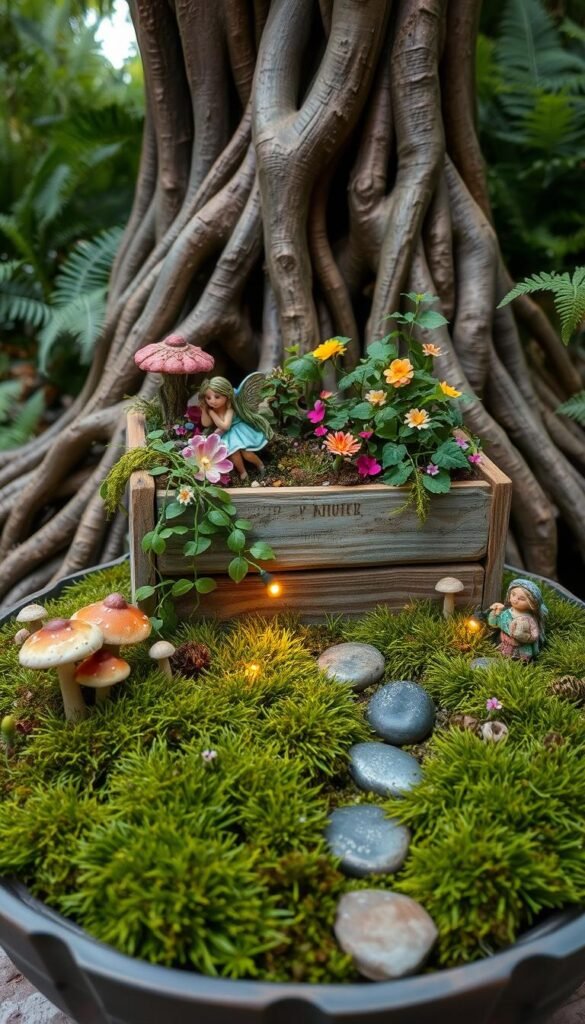Turn forgotten household items into charming tiny worlds that spark joy. With basic supplies and everyday objects, you can design captivating scenes that fit anywhere – from apartment windowsills to backyard corners. A teacup, old toolbox, or cracked flowerpot becomes the perfect foundation for your vision.
This craft lets you reimagine storage clutter as artistic opportunities. Broken mugs find new life as cozy cottages, while yogurt containers transform into blooming planters. You control the size – start small with a jar lid scene or go big with a salvaged wheelbarrow display.
Upcycled materials make projects eco-friendly and budget-conscious. Instead of buying new items, use what you already own. Dry leaves become fairy carpets, bottle caps turn into stepping stones, and twigs form rustic fences. Seasonal updates keep displays fresh year-round.
Our guide walks through container choices, plant pairings, and weatherproofing tricks. Discover how to create beach themes with sand and shells or woodland scenes with moss and pebbles. Whether you’re new to gardening or a seasoned pro, these adaptable ideas work for all skill levels.
Introduction to the Magic of Fairy Gardens
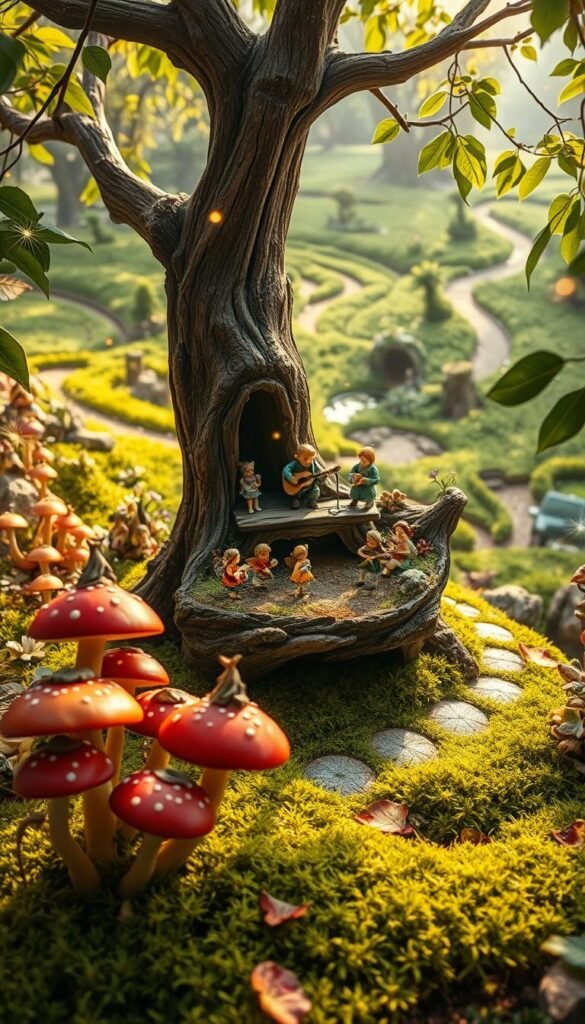
Building miniature ecosystems lets you blend nature with storytelling magic. These tiny worlds become portals to imagination, where pebbles transform into mountains and twigs shape into cozy benches. Both kids and adults find joy in arranging moss carpets, bottle-cap ponds, and clover-leaf umbrellas.
Designing these spaces offers surprising benefits beyond fun. Studies show hands-on activities like arranging miniature elements reduce stress by 37% compared to screen time. You’ll practice mindfulness while positioning tiny furniture or pruning thyme shrubs shaped like trees.
Families gain unique learning opportunities through these projects. Children discover:
- How sunlight affects succulent growth
- Water cycle basics through daily plant care
- Design balance using colorful stones and textures
| Benefit | Impact |
|---|---|
| Creative Expression | Boosts problem-solving skills |
| Nature Connection | Encourages outdoor exploration |
| Seasonal Updates | Teaches adaptation strategies |
| Collaborative Play | Strengthens family bonds |
No green thumb? No problem. Start with hardy air plants or faux moss from craft stores. Your first creation might fit in a cereal bowl – perfect for apartment dwellers. Swap seashells for autumn leaves when seasons change, keeping the magic alive year-round.
Why Choose Upcycled Containers for Your Fairy Garden
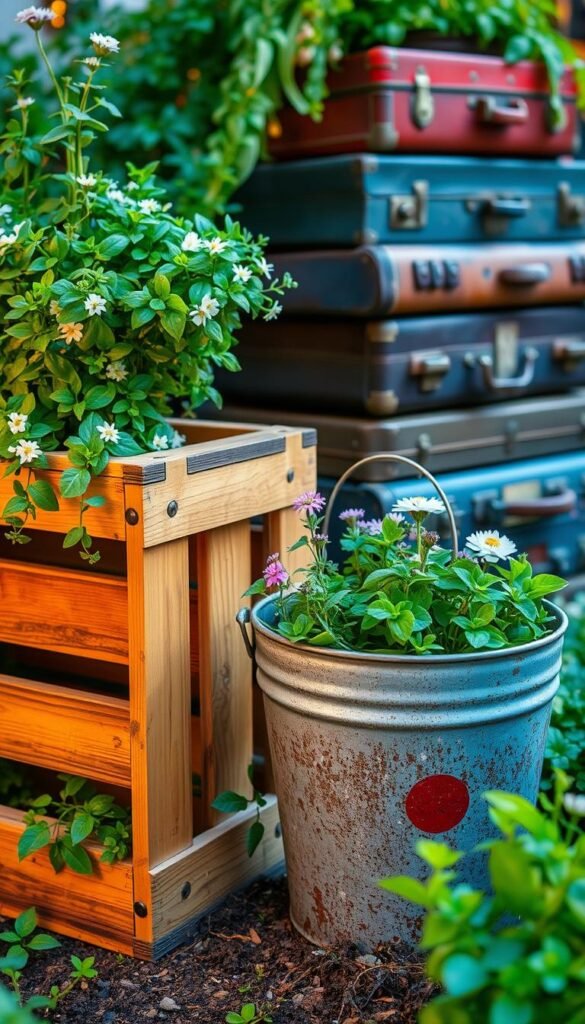
Creating tiny worlds in reused vessels benefits both planet and pocket. Old baking pans become shimmering ponds, while chipped bowls transform into lush landscapes. This approach lets you craft unique garden ideas while keeping materials out of landfills.
Eco-Friendly Benefits
Every repurposed item reduces waste. A single fairy garden made from salvaged materials can divert 3-5 pounds of household clutter annually. You’ll also cut plastic use – thrifted containers need no new packaging.
Check these environmental perks:
| Benefit Type | Key Advantage | Impact |
|---|---|---|
| Waste Reduction | Reuses 100% existing items | Lowers landfill contributions |
| Resource Savings | No manufacturing required | Reduces carbon emissions |
| Ecosystem Support | Promotes natural materials | Encourages biodiversity |
Cost-Effective Solutions
Your fairy garden doesn’t need pricey parts. Search closets for unused baskets or cracked planters. Thrift stores often sell containers under $2 – a great way to stretch your budget.
Salvaged items offer creative flexibility. Paint rusted tin cans as cottages or drill drainage holes in tea kettles. Unlike store-bought planters, these pieces already have character. Their dents and scratches add rustic charm that new items can’t match.
Getting Started: Selecting the Perfect Container
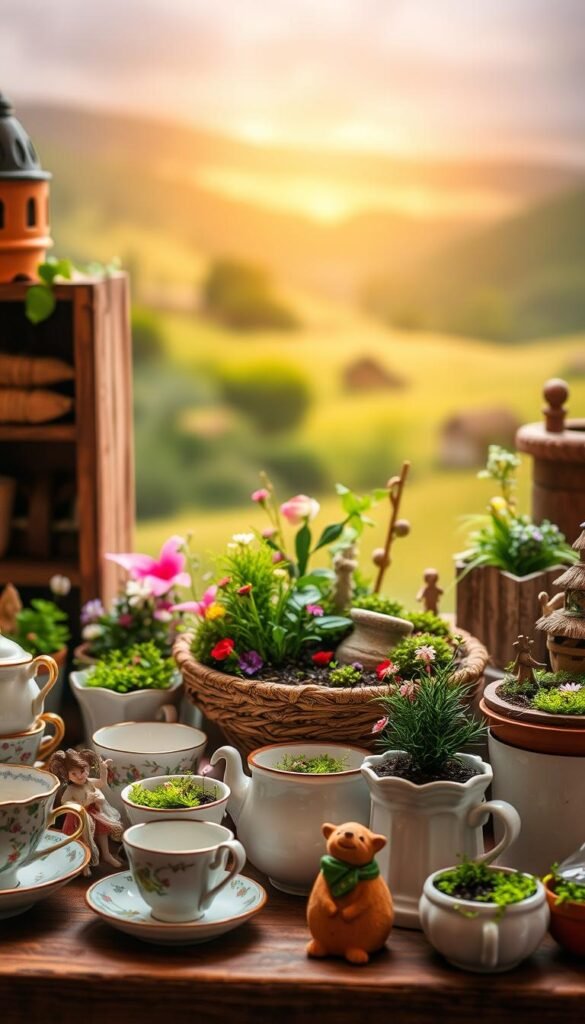
Your miniature landscape begins with choosing a base that balances function and charm. Wide, shallow containers work best – they give tiny plants room to breathe while leaving space for creative details. Don’t worry if your favorite planter seems too deep. Crushed plastic bottles at the bottom reduce soil needs and improve drainage.
Household Items You Can Repurpose
Look around your house first. That chipped colander makes a whimsical hanging basket, while unused flower pots become instant foundations. Thrift stores often hide gems like:
- Vintage teacups with hairline cracks
- Rustic wooden crates
- Metal lunchboxes needing new purpose
Ensuring Proper Drainage and Space
Every container needs escape routes for water. Drill holes in sealed items or layer pebbles beneath soil. For outdoor setups, consider material durability. A galvanized tin planter withstands rain better than untreated wicker.
| Container Type | Best Use | Prep Tip |
|---|---|---|
| Ceramic Bowls | Indoor displays | Add cork feet for airflow |
| Plastic Bins | Child-friendly projects | Poke side holes with soldering iron |
| Wooden Boxes | Rustic themes | Line with landscape fabric |
Remember scale – a 12-inch container fits a cottage with pathway, while smaller items like mugs suit single fairy benches. Local flea markets often stock unique vessels cheaper than craft stores.
Designing Your Enchanted Fairy Garden Layout
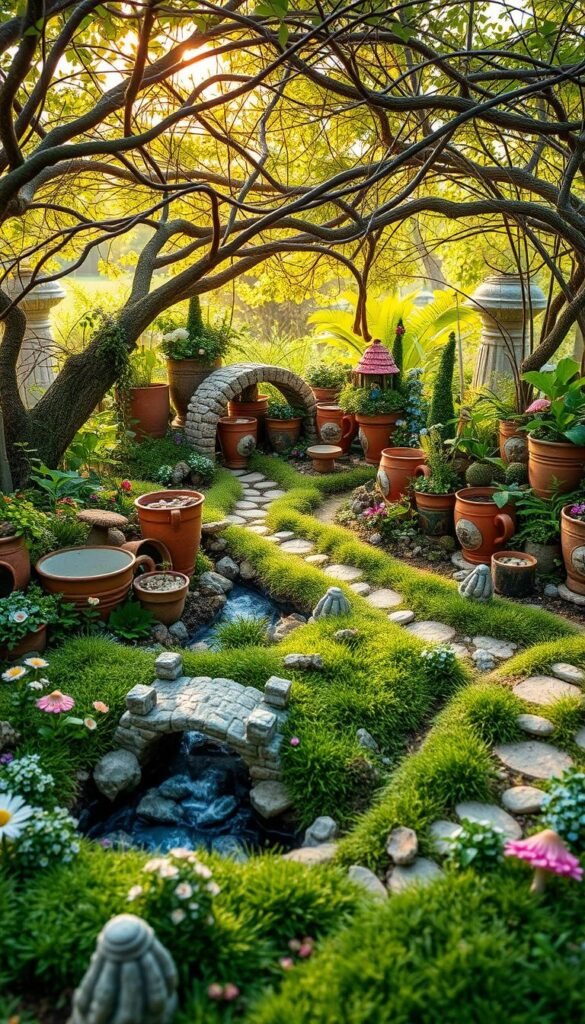
Transform ordinary materials into extraordinary landscapes through smart spatial planning. A thoughtful layout turns scattered elements into cohesive stories, where visitors’ eyes dance from mini pathways to hidden seating nooks. Start by sketching your vision on paper – mark where plants will thrive and where fairies might gather.
Crafting Pathways That Tell Stories
Create winding trails using sliced branches or flat pebbles. These routes should feel intentional but not rigid – imagine fairies hopping between moss patches and flower clusters. Vary stone sizes for natural-looking walkways, leaving space for tiny “rest stops” with acorn cap benches.
Balance your little scene with height variations. Use upright twigs as trees behind low-growing plants like creeping thyme. Cluster colorful flowers near your house structure to create focal points. This layering trick adds depth to even small spaces.
| Design Element | Materials | Pro Tip |
|---|---|---|
| Pathways | Birch slices, gravel | Angle stones diagonally for movement |
| Patios | Broken tile pieces | Grout with sand for realism |
| Plant Borders | Mini succulents | Use contrasting leaf textures |
| Open Spaces | Sand or soil | Leave 30% empty for “play areas” |
Remember: Your garden needs breathing room. Leave open zones between features so the scene doesn’t feel crowded. These blank spaces let you add seasonal updates later – maybe a pumpkin patch in fall or ice-skating pond in winter.
For lasting appeal, choose plants that stay small. Hens-and-chicks work as rosette trees, while Irish moss makes lush groundcover. Water sparingly – most fairy garden species prefer drier soil. Rotate sun-loving and shade-tolerant varieties based on your container’s location.
Homemade Fairy Garden Ideas for Upcycled Containers and Planters
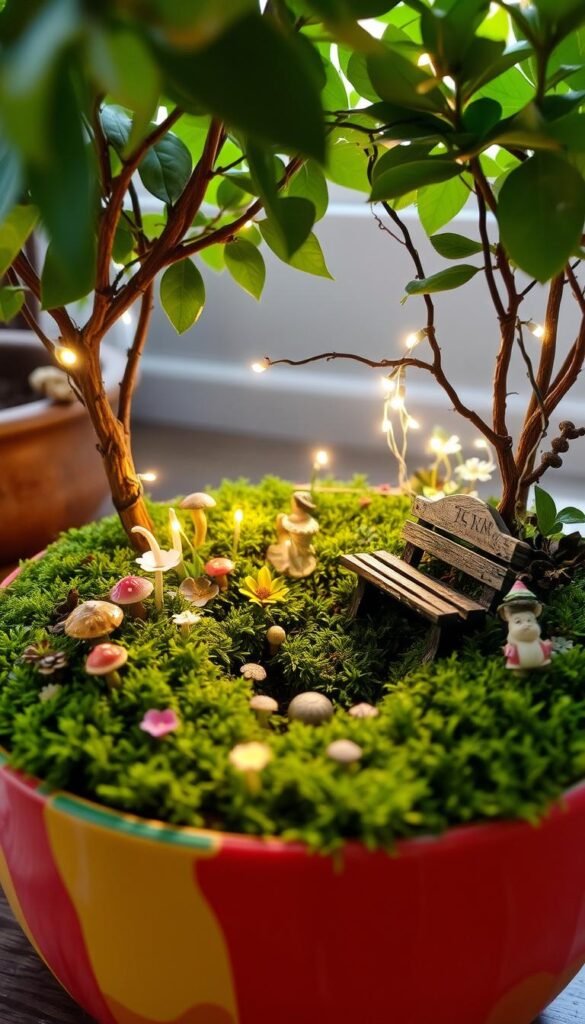
Transform discarded objects into storybook settings using clever arrangements. An antique wheel becomes a vintage scene when set in a shallow tray with succulents and tiny tools. Add miniature wagons or weathered signs to complete the rustic charm.
Empty wine bottles find new purpose as ivy-covered planters for vineyard-themed displays. Pair them with grape crate shelves and barrel stools around a bistro table. This setup works beautifully on patio ledges or kitchen windowsills.
Cabbage bowls burst with spring energy when filled with herb sprouts and veggie replicas. Nestle tiny watering cans between rosemary stems and radish markers. These edible arrangements smell fresh while teaching kids about plant growth cycles.
Coastal magic shines through glass jars layered with sand and sea treasures. Position miniature chairs beside shell pathways under a “driftwood” arch made from twigs. This portable beach scene brings summer vibes to any room.
Adapt these creative DIY projects to match your space and style. Mix elements from different themes – maybe add wine barrel planters to your rustic wheel display. Let your container’s shape guide the story, whether curved like shorelines or angular like vineyard trellises.
Inspiration from Real-Life DIY Fairy Garden Projects
Real-world creations prove imagination trumps perfection. Everyday items become extraordinary when paired with clever details and playful storytelling. Let these successful projects spark your next miniature masterpiece.
Rusty Wheel & Wine Cellar Inspirations
An antique twig chair paired with a wooden drawer planter shows how unexpected combos work. Add a colorful gnome among moss patches for instant charm. Repurposed wine bottle cages become Parisian café chairs when placed beside clock-face backdrops.
Unique Themes That Captivate
Coastal magic shines in a mini underwater realm featuring purple resin shells and air plants. For rustic elegance, cluster ceramic houses with cobblestone paths and trickling fountains. Even dollar store oil pans transform into whimsical tooth-themed gardens with DIY mailboxes.
These examples demonstrate one truth: your fairy garden thrives on personal touches. Use thrifted finds as jumping-off points, then layer in meaningful details. Whether crafting a seaside scene or European courtyard, let materials guide your story.
Ready to start your project? Grab that forgotten container and begin arranging. Every cracked teacup or weathered crate holds potential for magic. Your unique little scene awaits – no professional skills required.
FAQ
What household items can I repurpose for a miniature scene?
How do I ensure proper drainage in upcycled planters?
Can I use live plants in an indoor setup?
What themes work well for a tiny enchanted space?
How can I add details without breaking the bank?
FAQ
What household items can I repurpose for a miniature scene?
Look around your home for old teacups, mason jars, wooden crates, or even broken birdbaths. Baskets, colanders, and tin cans also work well. The Dollar Store often has affordable items like small trays or ceramic pots that add charm.
How do I ensure proper drainage in upcycled planters?
Drill small holes in the bottom of your container if possible. Layer pebbles or gravel at the base before adding soil. For non-drillable materials like baskets, use a plastic liner with drainage slits to protect against root rot.
Can I use live plants in an indoor setup?
Absolutely! Succulents, moss, and miniature ferns thrive indoors. Pair them with faux plants for texture. Place your creation near a window for indirect light, and water sparingly to keep the scene lush.
What themes work well for a tiny enchanted space?
Try rustic themes with scrap wood bridges, beachy vibes with sand and shells, or whimsical styles using popsicle stick fences. Wine cellar-inspired designs with cork pathways or rusty wheel accents add unique flair.
How can I add details without breaking the bank?
Raid your craft stash for buttons, beads, or broken jewelry to create pathways or fairy doors. Use twigs and acorns from outside for natural elements. Thrift stores often sell tiny figurines or decorative stones for under
FAQ
What household items can I repurpose for a miniature scene?
Look around your home for old teacups, mason jars, wooden crates, or even broken birdbaths. Baskets, colanders, and tin cans also work well. The Dollar Store often has affordable items like small trays or ceramic pots that add charm.
How do I ensure proper drainage in upcycled planters?
Drill small holes in the bottom of your container if possible. Layer pebbles or gravel at the base before adding soil. For non-drillable materials like baskets, use a plastic liner with drainage slits to protect against root rot.
Can I use live plants in an indoor setup?
Absolutely! Succulents, moss, and miniature ferns thrive indoors. Pair them with faux plants for texture. Place your creation near a window for indirect light, and water sparingly to keep the scene lush.
What themes work well for a tiny enchanted space?
Try rustic themes with scrap wood bridges, beachy vibes with sand and shells, or whimsical styles using popsicle stick fences. Wine cellar-inspired designs with cork pathways or rusty wheel accents add unique flair.
How can I add details without breaking the bank?
Raid your craft stash for buttons, beads, or broken jewelry to create pathways or fairy doors. Use twigs and acorns from outside for natural elements. Thrift stores often sell tiny figurines or decorative stones for under $1.
Are there low-maintenance options for busy creators?
Opt for drought-tolerant plants like sedum or air plants. Use preserved moss instead of live varieties to reduce watering needs. Arrange your layout with removable features for easy updates when time is tight.
.
Are there low-maintenance options for busy creators?
Opt for drought-tolerant plants like sedum or air plants. Use preserved moss instead of live varieties to reduce watering needs. Arrange your layout with removable features for easy updates when time is tight.

